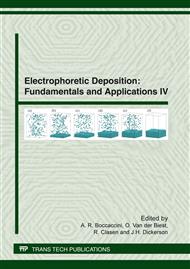[1]
A.G. Evans, A.H. Heuer, Review—transformation toughening in ceramics: martensitic transformations in crack-tip stress fields. J. Am. Ceram. Soc. 63 (1980) 241–248.
DOI: 10.1111/j.1151-2916.1980.tb10712.x
Google Scholar
[2]
R.C. Garvie, R.H. Hannink, R.T. Pascoe, Ceramic steel?, Nature 258 (1975) 703–704.
DOI: 10.1038/258703a0
Google Scholar
[3]
J. Green, R.H. Hannink, M.V. Swain, Transformation toughening of ceramics, Boca Raton (Florida), CRC Press Inc.; (1989).
Google Scholar
[4]
H. Hadraba, K. Maca, J. Cihlář, Electrophoretic deposition of alumina and zirconia – II. Two-component systems, Ceram. Int. 30 (2004) 853-863.
DOI: 10.1016/s0272-8842(03)00208-6
Google Scholar
[5]
A.G. Evans, Perspective on the development of high-toughness ceramics, J. Am. Ceram. Soc. 73 (1990) 187-206.
Google Scholar
[6]
H. Hadraba, J. Klimeš, K. Maca, Crack propagation in layered Al2O3/ZrO2 composites prepared by electrophoretic deposition, J. Mat. Sci. 42 (2007) 6404-6411.
DOI: 10.1007/s10853-006-1197-y
Google Scholar
[7]
H. Hadraba, K. Maca, Z. Chlup, Alumina and zirconia based composites: Part 1 Preparation, Key Eng. Mat. 412 (2009) 221-226.
DOI: 10.4028/www.scientific.net/kem.412.221
Google Scholar
[8]
S. Iijima, Helical microtubules of graphitic carbon, Nature 354 (1991) 56-58.
DOI: 10.1038/354056a0
Google Scholar
[9]
M. Woydt, J. Kadoori, K. -H. Habig, H. Hausner, Unlubricated sliding behaviour of various zirconia-based ceramics, J. Eur. Ceram. Soc. 7 (1991) 135-145.
DOI: 10.1016/0955-2219(91)90031-t
Google Scholar
[10]
P. Hvizdoš, A. Duszová, V. Puchý, O. Tapasztó, P. Kun, J. Dusza, C. Balázsi, Wear behavior of ZrO2-CNF and Si3N4-CNT nanocomposites, Key Eng Mat 465 (2011) 495-498.
DOI: 10.4028/www.scientific.net/kem.465.495
Google Scholar
[11]
J. Vleugels, G. Anné, S. Put, O. van Der Biest, Thick Plate-Shaped Al2O3/ZrO2 Composites with Continuous Gradient Processed by Electrophoretic Deposition, Functionally Graded Materials VII, Trans Tech Publications, Switzerland, 2003, 171-176.
DOI: 10.4028/www.scientific.net/msf.423-425.171
Google Scholar
[12]
K. Maca, H. Hadraba, J. Cihlář, Electrophoretic deposition of alumina and zirconia – I. Single-component systems, Ceram. Int. 30 (2004) 843-852.
DOI: 10.1016/s0272-8842(03)00209-8
Google Scholar
[13]
W.C. Oliver, G.M. Pharr, An improved technique for determining hardness and elastic modulus using load and displacement sensing indentation experiments, J. Mat. Res. 7 (1992), 1564-1583.
DOI: 10.1557/jmr.1992.1564
Google Scholar


